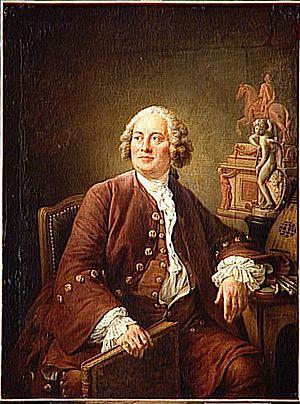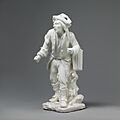Edmé Bouchardon facts for kids
Quick facts for kids
Edmé Bouchardon
|
|
|---|---|

Portrait of Bouchardon by François-Hubert Drouais in 1758.
|
|
| Born |
Edmé Bouchardon
29 May 1698 Chaumont-en-Bassigny, France
|
| Died | 27 July 1762 (aged 64) Paris, France
|
| Nationality | French |
| Known for | Sculpture |
|
Notable work
|
Fontaine des Quatre-Saisons |
Edmé Bouchardon (May 29, 1698 – July 27, 1762) was a famous French sculptor. He is known for his neoclassical statues, especially those in the gardens of the Palace of Versailles. He also designed medals and a large statue of King Louis XV for the Place de la Concorde in Paris. This statue was later destroyed during the French Revolution. Another important work is the Fountain of Four Seasons in Paris. Besides sculpting, Bouchardon was also a talented artist who made drawings and paintings. He created a well-known series of drawings showing everyday people in Paris.
Contents
Biography of Edmé Bouchardon
Early Life and Training
Edmé Bouchardon was born in Chaumont-en-Bassigny, France. His father, Jean-Baptiste Bouchardon, was also a sculptor and an architect. Edmé first learned about sculpture in his father's workshop. Later, he studied with another famous sculptor, Guillaume Coustou.
In 1722, Bouchardon won the Prix de Rome. This was a special award from the Académie royale de peinture et de sculpture. Winning it meant he could live and work in Rome, Italy, for ten years, from 1722 to 1732.
Time in Rome and New Style
While in Rome, Bouchardon started to move away from the very fancy and decorated Rocaille style. Instead, he preferred a simpler, more classical style known as neoclassicism. He made busts (sculptures of heads and shoulders) for important people, including Pope Benedict XIII.
In 1726, he began making a copy of an ancient Greek sculpture called the Barberini Faun. His copy arrived in France in 1732. People admired it greatly because it helped French sculpture shift towards the neoclassical style. Later, in 1775, the duc de Chartres bought it for his garden. Today, you can see it in the Louvre Museum in Paris.
Return to France and Royal Works
When Bouchardon returned to France, he started working for the king at the Palace of Versailles. He worked with his two brothers, creating statues for the beautiful Gardens of Versailles. He continued to use his classical style, which was different from the popular Rocaille style of other artists at the time.
One of his most famous works for Versailles was "Cupid Fashioning a Bow out of the Club of Hercules." This sculpture is now in the Louvre. It showed Cupid, the god of love, as a realistic, unidealized teenager in a natural pose. This was very different from the perfect, idealized figures usually seen in classical art.
Bouchardon first showed a small clay model of this work in 1739. Then, he made a full-size model in 1746. The king then asked him to create a marble version, which he finished between 1747 and 1750. This sculpture made him very famous and wealthy. He was paid a huge amount of money for it.
The Fountain of Four Seasons
Bouchardon's last major completed sculpture was the Fontaine des Quatre-Saisons (Fountain of Four Seasons) in Paris. He started working on it in 1739 and finished it six years later, in 1745. The fountain has classical columns and statues. Its design was similar to the statues made by Michelangelo in the Medici Chapel in Florence, Italy.
Many people admired Bouchardon's sculpture. It was even shown in a famous French book called the Encyclopedia in 1765. However, some people also criticized it. The fountain was very large and beautiful, but it was built on a narrow street and only had a tiny trickle of water.
The famous writer Voltaire criticized the fountain in a letter in 1739, while it was still being built. He said:
I have no doubt that Bouchardon will make of this fountain a fine piece of architecture; but what kind of fountain has only two faucets where the water porters will come to fill their buckets? This isn't the way fountains are built in Rome to beautify the city. We need to lift ourselves out of taste that is gross and shabby. Fountains should be built in public places, and viewed from all the gates. There isn't a single public place in the vast faubourg Saint-Germain; that makes my blood boil. Paris is like the statue of Nabuchodonosor, partly made of gold and partly made of muck.
Equestrian Statue of Louis XV
Bouchardon was asked to create one last big project: a statue of King Louis XV on horseback. This statue was meant for the Place de la Concorde in Paris. It was to celebrate France's victory in the War of Austrian Succession. Bouchardon died before he could finish it. Another sculptor, Jean-Baptiste Pigalle, completed the work. Sadly, this statue was destroyed during the French Revolution.
Jetons (Metal Tokens)
Bouchardon also designed jetons. These were special metal tokens that the King gave out. The ideas for these tokens were chosen by a group called the Académie des Inscriptions et Belles-Lettres. The designs went through many checks, and even the King had to approve them. Today, drawings and copies of these jetons are kept in museums and collections around the world.
Family Life
Edmé Bouchardon had a brother named Jacques-Philippe Bouchardon. Jacques-Philippe was also a sculptor. He became the main sculptor for the king of Sweden.
Drawings and Etchings
Bouchardon was very good at drawing. He created two series of drawings showing working people on the streets of Paris. He often used sanguine, which is a reddish chalk, for his drawings.
His drawings were first used to make smaller ceramic sculptures of Parisian characters, like street vendors. Later, a historian and engraver named Anne Claude de Caylus turned them into a series of etchings. These etchings were called Studies made of the Lower Class or the Cries of Paris. They became a very important source of information for people studying history and society later on.
Images for kids
See also
 In Spanish: Edmé Bouchardon para niños
In Spanish: Edmé Bouchardon para niños














